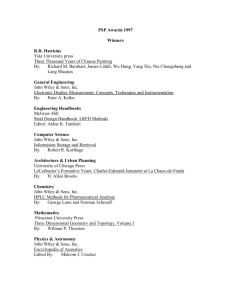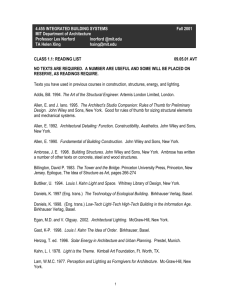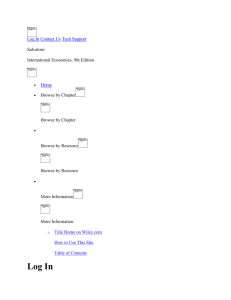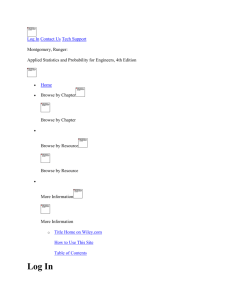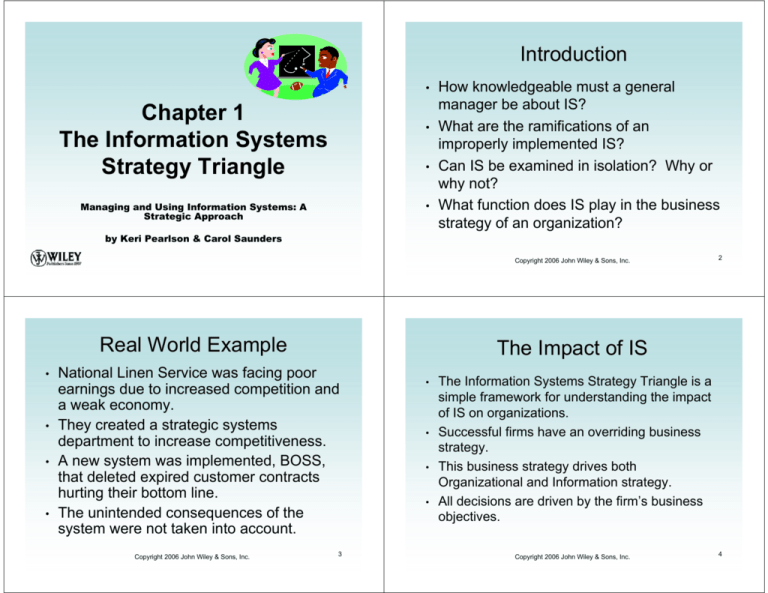
Introduction
•
Chapter 1
The Information Systems
Strategy Triangle
•
•
Managing and Using Information Systems: A
Strategic Approach
•
How knowledgeable must a general
manager be about IS?
What are the ramifications of an
improperly implemented IS?
Can IS be examined in isolation? Why or
why not?
What function does IS play in the business
strategy of an organization?
by Keri Pearlson & Carol Saunders
Copyright 2006 John Wiley & Sons, Inc.
Real World Example
•
•
•
•
The Impact of IS
National Linen Service was facing poor
earnings due to increased competition and
a weak economy.
They created a strategic systems
department to increase competitiveness.
A new system was implemented, BOSS,
that deleted expired customer contracts
hurting their bottom line.
The unintended consequences of the
system were not taken into account.
Copyright 2006 John Wiley & Sons, Inc.
2
3
•
•
•
•
The Information Systems Strategy Triangle is a
simple framework for understanding the impact
of IS on organizations.
Successful firms have an overriding business
strategy.
This business strategy drives both
Organizational and Information strategy.
All decisions are driven by the firm’s business
objectives.
Copyright 2006 John Wiley & Sons, Inc.
4
IS Strategy Triangle
•
•
•
•
Figure 1.1 The Information Systems Strategy Triangle
Copyright 2006 John Wiley & Sons, Inc.
•
5
Business Strategy drives all other strategies.
Organizational and Information Strategy are
then dependent upon the Business Strategy.
Changes in any strategy requires changes in the
others to maintain balance.
IS Strategy is affected by the other strategies a
firm uses.
IS strategy always involves consequences.
Copyright 2006 John Wiley & Sons, Inc.
6
Think About IT
BRIEF OVERVIEW OF
BUSINESS STRATEGY
FRAMEWORKS
•
•
•
•
What is a business strategy?
Which factors influences a business
strategy?
How does a business change its strategy
without losing balance within its
organization and IS structure?
Are there specific events that induce a
business to change its strategies and what
are they?
Copyright 2006 John Wiley & Sons, Inc.
8
Generic Strategies Framework
•
•
Michael Porter describes how businesses
can build a sustainable competitive
advantage.
He identified three primary strategies for
achieving competitive advantage:
•
•
•
Cost leadership – lowest-cost producer.
Differentiation – product is unique.
Focus – limited scope.
Figure 1.2 Three strategies for achieving competitive advantage.
9
Copyright 2006 John Wiley & Sons, Inc.
Porter’s Competitive Advantage
•
•
•
•
•
Remember that a companies overall business
strategy will drive all other strategies.
Porter defined these competitive advantages to
represent various business strategies found in
the marketplace.
Cost leadership strategy firms include Walmart,
Suzuki, Overstock.com, etc.
Differentiation strategy firms include Coca Cola,
Progressive Insurance, Publix, etc.
Focus strategy firms include the Ritz Carlton,
Marriott, etc.
Copyright 2006 John Wiley & Sons, Inc.
11
Copyright 2006 John Wiley & Sons, Inc.
10
Differentiation Strategy Variants
•
•
•
Shareholder value model: create advantage
through the use of knowledge and timing
(Fruhan)
Unlimited resources model: companies with a
large resource can sustain losses more easily
than ones with fewer resources (Chain Store vs
Mom & Pop).
The problem with Porter and these variants are
that the rate of change is no longer easily
managed and sustained.
Copyright 2006 John Wiley & Sons, Inc.
12
Hypercompetition
•
•
•
•
D’Aveni developed a model that stated
that sustainable competitive advantage
could NOT be sustained.
Called the “Hypercompetition and the New
7 Ss Framework”.
Competitive advantage is rapidly erased
by competition and the market.
Copyright 2006 John Wiley & Sons, Inc.
Assumptions of D’Avenis
Hypercompetition and the New 7 Ss
Framework model:
•
•
•
•
13
Every advantage is eroded.
Sustaining an advantage can be a deadly
distraction.
Goal of advantage should be disruption, not
sustainability
Initiatives are achieved through series of
small steps.
Copyright 2006 John Wiley & Sons, Inc.
14
D’Aveni’s new 7 Ss
•
•
1. Superior stakeholder satisfaction: maximize customer satisfaction by
adding value strategically
2. Strategic soothsaying: use new knowledge to predict new windows of
opportunity
3. Positioning for speed: prepare the org. to react as fast as possible
4. Positioning for surprise: surprise competitors
5. Shifting the rules of competition: serve customers in novel ways
6. Signaling strategic intent: communicate intensions in order to stall
competitors
7. Simultaneous and sequential strategic thrusts: take steps to stun and
confuse competitors in order to disrupt or block their efforts
Figure 1.3 Disruption and the new 7 Ss
Copyright 2006 John Wiley & Sons, Inc.
The 7 Ss are useful for determining different
aspects of a business strategy and aligning them to
make the organization competitive in the
hypercompetitive arena.
The 7 Ss are (see Figure 1.4):
15
Copyright 2006 John Wiley & Sons, Inc.
16
IS Planning and Strategic
Advantage Models
Application of Hypercompetition
•
•
•
General Electric applied the Hypercompetition
Model to its business units in the Destroy Your
Business (DYB) project.
GE recognized that if they didn’t understand and
recognize their own weaknesses they could not
remain competitive.
Employees were tasked to determine ways to
“destroy their business unit”. Once they have
identified these areas of weakness they apply
the Grow Your Business (GYB) strategy to find
fresh ways to reach new customers and better
serve existing customers.
Copyright 2006 John Wiley & Sons, Inc.
17
Framework
Key Idea
Porter’s
generic
strategies
framework
Firms achieve
Understanding which strategy is chosen by
competitive
a firm is critical to choosing IS to
advantage through complement that strategy.
cost leadership,
differentiation, or
focus.
D’Aveni’s
hypercompetition
model
Speed and
aggressive moves
and countermoves
by a firm create
competitive
advantage
•
•
•
•
•
General Managers cannot afford to rely solely
on IS personnel to make IS decisions.
Business strategy drives IS decision making.
Changes in IS potential should trigger business
reassessments (i.e. the Internet).
Information Systems Strategy Triangle shows
the proper balance of strategies.
The models are helpful in discussing the role of
IS in building and sustaining competitive
advantage.
Copyright 2006 John Wiley & Sons, Inc.
18
Application to Information Systems
The 7 Ss give the manager suggestions on
what moves and countermoves to make.
IS are critical to achieve the speed needed
for these moves.
BRIEF OVERVIEW OF
ORGANIZATIONAL
STRATEGIES
Figure 1.5 Summary of key strategy frameworks.
Copyright 2006 John Wiley & Sons, Inc.
19
Copyright 2006 John Wiley & Sons, Inc.
20
Organizational Strategy
•
•
•
•
Organizational strategy includes the
organization’s design as well as the choices it
makes in its work processes.
How will the company organize in order to
achieve its goals and implement its business
strategy?
Business Diamond – simple framework for
identifying crucial components of an
organization’s plan (Figure 1.6)
Managerial Levers – another framework for
organizational design, states that successful
execution of the firm’s organizational strategy is
the best combination of organizational, control,
and cultural variables (Figure 1.7).
Copyright 2006 John Wiley & Sons, Inc.
Figure 1.6 The Business Diamond
21
Copyright 2006 John Wiley & Sons, Inc.
22
Understanding Organization Strategy
To understand organizational strategy we must
answer the following questions:
1. What are the important structures and reporting
relationships within the organization?
2. What are the characteristics, experiences, and
skill levels of the people within the organization?
3. What are the key business processes?
4. What control systems are in place?
5. What is the culture of the organization?
Figure 1.7 Managerial Levers
Copyright 2006 John Wiley & Sons, Inc.
23
Copyright 2006 John Wiley & Sons, Inc.
24
Framework
Key Idea
Usefulness in IS Discussions
Business
Diamond
There are 4 key
components of an
organization: business
processes, values and
beliefs, management
control systems, and
tasks and structures.
Using IS in an organization will affect
each of these components. Use this
framework to identify where these
impacts are likely to occur
Organizational
variables, control
variables, and cultural
variables are the levers
managers can use to
affect change in their
organizations
This is a more detailed model than
the Business diamond and gives
specific areas where IS can be used
to manage the organization and to
change it
Managerial
levers
BRIEF OVERVIEW OF
INFORMATION SYSTEMS
STRATEGY
Figure 1.8 Summary of organizational strategy frameworks
Copyright 2006 John Wiley & Sons, Inc.
25
What
IS Strategy
•
•
•
•
•
The plan an organization uses in providing
information services.
IS allows business to implement its business
strategy.
IS helps determine the company’s capabilities.
Four key IS infrastructure components are key to
IS strategy (Figure 1.9)
These key components are sufficient to allow the
general manager to assess critical IS issues.
Copyright 2006 John Wiley & Sons, Inc.
27
Who
Where
Hardware
List of physical
components of the
system
Individuals who use it Physical location
Individuals who
manage it
Software
List of programs,
applications, and
utilities
Individuals who use it What hardware it
resides upon and
Individuals who
where that hardware
manage it
is located
Networking
Diagram of how
hardware and
software
components are
connected
Individuals who use
it/ Individuals who
manage it/
Company service
obtained from
Data
Bits of information
stored in the system
Individuals who use it Where the
information resides
Individuals who
manage it
Where the nodes are
located, where the
wires and other
transport media are
located
Figure 1.9 Information systems strategy matrix.
Copyright 2006 John Wiley & Sons, Inc.
28
Information vs Things
•
FOOD FOR THOUGHT:
ECONOMICS OF
INFORMATION VS.
ECONOMICS OF THINGS
Every business is in the information business
(Evans and Wurster).
•
All forms of industry rely heavily on IS.
•
•
•
•
•
Mercedes cars computing power.
Marketing research, logistics, advertising, inventory
management all rely on IS.
Things wear out.
Information never wears out.
Figure 1.10 compares things with information.
Copyright 2006 John Wiley & Sons, Inc.
Things
30
Information
Wear out
Doesn’t wear out, but can become
obsolete or untrue
Are replicated at the expense of
the manufacturer
Is replicated at almost zero cost
without limit
Exist in a tangible form
May exist in the ether
When sold, seller ceases to own
When sold, seller may still
possess and sell again
Price based on production costs
Price based on value to consumer
SUMMARY
Figure 1.10 Comparison of the economics of things with the economics of information
Copyright 2006 John Wiley & Sons, Inc.
31
Copyright 2006 John Wiley & Sons, Inc.
32
Summary
•
•
•
•
Competitive advantage is gained through cost
leadership, differentiation, or focus.
The Information Systems Strategy Triangle
shows that business strategy always drives
organizational and information strategies.
Hypercompetition defines competitive advantage
as temporary.
Understanding the influence of IS in
organizational strategy is paramount.
Copyright 2006 John Wiley & Sons, Inc.
33
•
Copyright 2006 John Wiley & Sons, Inc.
•
All rights reserved. Reproduction or translation of this work beyond that
named in Section 117 of the 1976 United States Copyright Act without the
express written consent of the copyright owner is unlawful. Request for
further information should be addressed to the Permissions Department,
John Wiley & Sons, Inc. The purchaser may make back-up copies for
his/her own use only and not for distribution or resale. The Publisher
assumes no responsibility for errors, omissions, or damages, caused by the
use of these programs or from the use of the information contained herein
Copyright 2006 John Wiley & Sons, Inc.
34



